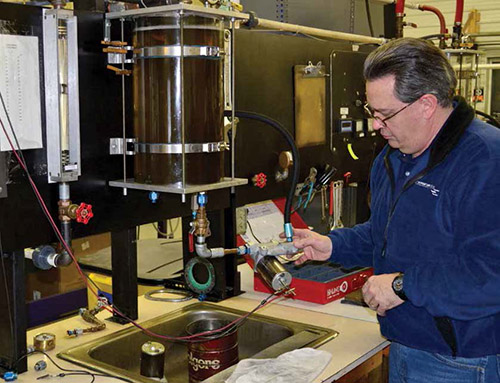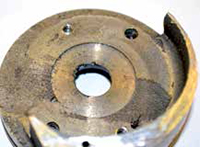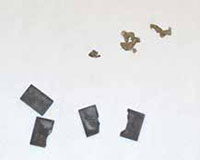
Proper Care and Maintenance of Fuel Pumps


We don’t often think about helicopter in-tank and in-line (auxillary and boost) fuel pumps until they fail. Fuel pumps do their job day in and day out – but they don’t last forever. This article will provide some tips to ensure you are properly maintaining and inspecting the fuel pump and fuel system to get the most out of your fuel pumps.
Pump Design
Many auxillary and boost type fuel pumps are direct current (DC) motors. 12V or 24V DC electrical power is applied to the pumps and this power transfers to carbon brushes that ride against a commutator. The electrical charge sent through the commutator to the armature causes the copper windings in the armature to act as electromagnets. The resulting attraction/repulsion of the magnetic fields between the armature and fixed magnets in the pump housing causes the armature to turn.
There are two basic types of fuel pumps (plus a combination-type pump):
Constant displacement. Constant displacement pumps are in-line pumps such as boost pumps and transfer pumps, depending on the airframe application. “Constant displacement pumps have a metal rotor with four slots where carbon vanes sit in,” says Barrett (Bart) J. Briggs, vice president and general manager for Monroe, WI-based Fleet Support Services, Inc. (an FAA Repair Station that overhauls fuel pumps and is affiliated with Rapco, Inc.) “The vanes spin around in an elliptical cavity. Fuel comes in through the larger portion of the cavity, and as the carbon vane pushes it though the narrow portion of the cavity, it is pushing the large volume of fuel through the narrow portion under pressure. For every revolution, there is a constant displacement of fuel pushed through the pump.”
Centrifugal. Centrifugal pumps are what we would call cartridge pumps. They use a disk-like impeller to pump the fuel. The cavity where the impeller sits in is round. The impeller has openings towards its center where the fuel is picked up. As the impeller spins, the fuel is pushed by centrifugal action through channels inside the impeller, and exits through outlets on the impeller’s edges. “This is high-flow, but low-pressure pump,” explains Briggs. “Centrifugal pumps don’t generate a lot of pressure. They move a lot of volume, but at minimal pressure because there is not a lot of pressure pushing the fuel like the vanes in constant displacement pumps.”
Duplex. There are also duplex pumps that are a combination of constant displacement and centrifugal pumps. They have both centrifugal impeller and a rotor with carbon vanes.
Now that we know some basic fuel pump theory, we can cover some scenarios where the pumps can be damaged.
Corrosion
Corrosion can cause external and internal damage to fuel pumps. Externally, corrosion can build up on the pump housing and on the electrical terminals and wiring. Helicopters operated in coastal areas like we see in offshore oil operations are more susceptible to corrosion because of the high-salinity in the environment. Corrosion on the housing won’t necessarily cause a pump to fail, but the corrosion should be removed and the area treated during scheduled inspections. Corrosion on the terminals or in the wiring can affect electrical conductivity, and any damaged wiring or terminals should be repaired or replaced as necessary. “Corrosion will build up an electrical resistance in the circuit,” says Briggs. “So you have to push more current through the wire to get the pump to produce same power. With voltage being a constant, if you have a resistance problem in the power or ground, you start increasing current and this increases heat (Ohm’s Law). So look for indications of heat-damaged wiring and terminals when you are inspecting corrosion.”
“It helps to apply a good corrosion preventative such as ACF-50 to the external surface of the pump to prevent any potential problems corrosion can cause,” adds Mike Lotzer, national sales manager for Hartland, WI-based Rapco, Inc.


Internally, the biggest cause of corrosion is water. This is especially true with jet fuel, where microbes like to thrive in the boundary area between the water and the fuel, creating a corrosive sludge by-product. Regular and proper fuel sumping will help reduce internal corrosion issues. “You also need to know you are getting good fuel to begin with,” says Briggs. “Fuel trucks should incorporate proper fuel filtering, regular sumping, and treatment with additives such as Prist or Biobor in the recommended mixture ratios.”
FOD
In constant displacement pumps, the carbon vanes are relatively soft. Briggs demonstrated to us how “soft” these vanes are as he rubbed a carbon vane against a sheet of paper, and a soft grey shading appeared on the paper. “The carbon in these vanes is about as hard as a hard pencil lead,” explains Briggs. “These carbon vanes are spinning in the pump at several thousand RPM. If any foreign object debris (FOD) is introduced, such as rag pieces, paint chips, ect., it can damage the vanes. The edges of the vanes will break and the pump will lose pressure.”


Centrifugal pumps don’t have floating carbon vanes that can be damaged. But the impeller disk is not immune to degraded output from FOD. If there is FOD in the fuel system, it can be sucked up though the openings in the center of the impeller. If these openings or the internal vane channels in the impeller become blocked, fuel cannot flow out through centrifugal force, and a loss in pressure results.
How do you prevent FOD damage? Keep it clean! “You would be surprised how even a small piece of debris can damage your fuel pump,” says Lotzer. “If you are doing fuel cell work, make sure the area is clean before closing it up. Also, use clean, lint-free towels to wipe down the fuel cells. Even small chunks of debris left behind from a worn out red rag can damage a fuel pump.”
Debris left behind from worn out red rags can damage fuel pumps
Briggs adds, “I’ve been there. In my 35 years of fixing and flying aircraft, I’ve been in fuel tanks. It’s an ugly job. But you need to have the mindset right off the bat that you are going to take your time. Cleanliness is next to Godliness when it comes to fuel system maintenance. If you introduce any debris to a fuel tank and don’t get it back out, it’s going to end up going down the tube and will eventually end up in the pump or somewhere else and that’s never a good thing.”
Also be mindful of proper fuel tank repair and the age of your fuel lines. Debris from sloppy fuel tank repairs or from deteriorating linings in old fuel lines can also contribute to FOD damage.
Cavitation
Briggs tells Helicopter Maintenance magazine that there was a technical bulletin issued for Bell Jet Rangers in the ‘80s that addressed potential fuel pressure indication surges at altitude. “An operator of an older Jet Ranger contacted us up and asked us if we knew anything about fuel pressure indication surges at altitude,” he says. “He was operating at 4,000 feet field elevation, so he was starting off pretty high. But he said when he got to around 6,000 feet AGL, he started getting a fuel pressure light. I told him there was a bulletin published by Bell addressing the issue. With the centrifugal fuel pump, when the helicopter got higher, the engine fuel flow went lower because the engine would operate more efficiently at altitude – it would burn less fuel. Meanwhile, the fuel pump cartridge was still trying to pump the same amount of fuel to the engine when the engine wasn’t demanding it any more. When that starts to happen, if the impeller can’t continue to push fuel out, it gets back pressure on it and then it goes into cavitation.”
The solution for the problem called out in the technical bulletin (206-82-60) was to replace the plug adapter in the fuel pump with a new adapter that would allow for better pressure relief at altitude. In addition, the removed plug adapter could be modified to be reinstalled by drilling two additional holes into the plug adapter as called out in the bulletin.
Complete Pump Degradation, “The China Syndrome”
Mike Lotzer, national sales manager for Rapco, says pump cavitation can lead to an even bigger problem of fuel pump degradation they call “The China Syndrome.” “This example isn’t a helicopter, but a twin Cessna operator, but it can happen to any fuel pump,” Lotzer shares. “Around 15 years ago, an operator was going numerous aux/boost fuel pumps on his older Cessna 402B tip tanks. We had a lot of warranty claims come back from him and they were all burned up – the armatures were melted, the commutators were melted together, and the brushes were smoked. I finally went down to visit him and asked him if I could inspect the aircraft. He operated flights to and from the Bahamas daily. I noticed in the cockpit that the fuel selectors were on “Aux,” and the aircraft had just landed. It’s normal procedure in the check list on that plane to take off and land with the fuel boost pumps on low. Both fuel boost pumps were on low, but they weren’t on the main tanks, they were on the Aux tanks. The Aux/Boost fuel pumps on twin Cessnas with tip tanks are located within the tip tanks (main tanks). These pumps could not push fuel to the engines because of the fuel restriction at the fuel selector valve. The fuel continued to cavitate within the system thus overheating the pumps causing complete pump & armature failure.”
“If a fuel pump is running at rated voltage and amperage, and fuel is flowing through the pump, the fuel passing through and around the armature is enough to cool the pump,” adds Briggs. “But if you have a scenario where you shut off the engine, or the engine is at minimal power like at idle, and the pump is still running, it cavitates. Other than the relief valve on the pump, there is no way to relieve the pressure. So even if fuel exits through the relief valve, it re-enters the pump inlet and circulates back through the pump components. The pressure builds up, it exits the relief valve again and re-circulates through the pump. The fuel gets hotter through each cycle, causing this “China Syndrome.” The copper in the windings gets hot and expands. When the copper expands, it causes spitting the potting compound out between the bars of the laminations and off the ends. The epoxy gets into the pump and causes vane damage, and can even seize up the comp. That pump is done at that point.”
The worse-case scenario for the China Syndrome is when the engine is not running, but the pumps are,” Briggs adds. “There is absolutely no flow. If the engine is at idle, and the pump is left on for an extended period of time, the damage will still happen, but not as quickly.”


Put that Hammer Down!
“Ask an old-timer what the trick he uses when a DC motor doesn’t work, and he might say, ‘Get a hammer,’” Briggs tells Helicopter Maintenance magazine. “They might think that hitting the motor with a hammer will jiggle the brushes or the dead spot on the commutator. That is NEVER a good idea with a fuel pump. Although the housing on the bottom of the pumps looks thick, it’s not, and I have seem some of these come in caved in and cracked!”
“You’re going to end up pushing the armature up against the side of the bearing housing,” adds Lotzer. “It’s not going to work. Don’t beat on them!”
If you don’t bang on them with hammers, keep your fuel system FOD- and water-free, inspect for any external corrosion and treat it, and prevent operating them in self-destructive “China Syndrome” scenarios, you will go a long way to help ensure you get the most from your fuel pumps!
